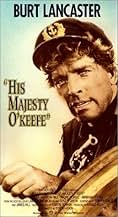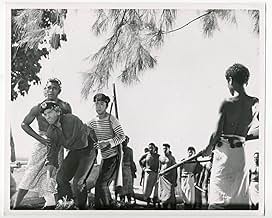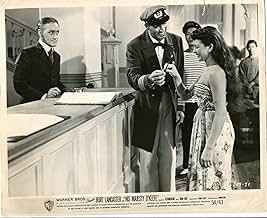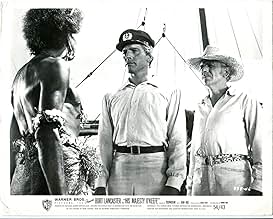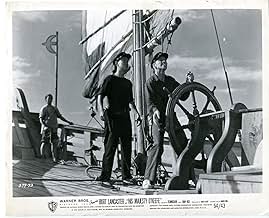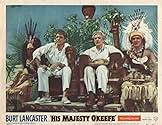CALIFICACIÓN DE IMDb
6.1/10
1.5 k
TU CALIFICACIÓN
Agrega una trama en tu idiomaA Yankee sea captain has adventures in paradise trying to become an entrepreneur in Micronesia.A Yankee sea captain has adventures in paradise trying to become an entrepreneur in Micronesia.A Yankee sea captain has adventures in paradise trying to become an entrepreneur in Micronesia.
- Dirección
- Guionistas
- Elenco
André Morell
- Alfred Tetins
- (as Andre Morell)
Jimmy Dime
- Sailor at Table in Saloon
- (sin créditos)
Sol Gorss
- Tough Sailor in Fight
- (sin créditos)
Hugh McLardy
- Hong Kong Tailor
- (sin créditos)
Paddy Mulelly
- J.R. Beldon, Bank Manager
- (sin créditos)
Opiniones destacadas
This film is not Lancaster's best but is enjoyable if you enjoy watching him in his athletic prime. Beautifully shot, it captures the exciting times of adventure on the high seas and island exploration. The plot is fairly insubstantial and there's nothing new here but at just over 90 minutes, the story never drags. Definitely worth a look if you're a fan of Burt's.
This is an amusing and fun movie , although heavily Hollywoodized, the film is based on real individuals and events . Here Burt Lancaster is the complete show , he played this adventure movie in the wake of his man-of-action epoch when he performed three magnificent movies that included ¨Crimson pirate¨ , ¨The Flame and the Arrow¨ and this one . Based on a real-life American adventurer , a Yankee sea captain who has adventures in paradise trying to become an entrepreneur in Micronesia. The entire picture was photographed in the South Pacific , where for years the basic economy and wealth revolved around the dried meat of coconut , known as Copra . And in the Island of Yap the natives worshipped an exotic sacred stone they called ¨Fei¨. It deals with Lancaster's attempts to make fame and fortune out of pearls or anything else he can lay his hands on , when he's not fighting gangs of pirates , he then became involved into the lucrative coconut-oil trade of the mid-1800s . There the disgruntled natives see him as a god and allow him to marry a charming maiden . When his kingdom is threatened by unscrupulous German traders , Burt springs into action to safeguard his kingdom .
Agreeable as well as entertaining adventure movie , plenty of action , thrills , bright cinematography and exotic scenarios . Although the story has been told before , tight filmmaking and nice acting win out . The picture is fast-moving , exciting and thrilling ; however the scenic qualities of the movie are rather better than the disjointed screenplay by Borden Chase and James Hill , being suggested by a novel from Lawrence Klingman and Gerald Green . ¨His Majesty O'Keefe¨ results to be one of Lancaster's swashbuckling best and has achieved a good status along with ¨Crimson pirate¨(1952) and ¨The Flame and the Arrow¨(1950) , all of them made during star Burt Lancaster's athletic and swashbuckler period . Because of cost overruns on "The Crimson Pirate" and "His Majesty O'Keefe," Warner Brothers insisted that future films from Hecht/Lancaster be limited to $900,000 ; then Lancaster and Hecht's response was to strike a new deal with United Artists. The cast is frankly well such as Andre Morell as a friendly trader , Abraham Sofaer as a medicine man and a gorgeous young Joan Rice . The producers , the notorious team formed by Harold Hecht-James Hill-Lancaster wish to acknowledge their gratitude to the Secretary for Fijian Affairs , to Ratu Penaia La La Latiamara , Serua District Chief in Charge and to the wonderful people of the Fiji Islands . Colorful cinematography shot on location by Otto Heller , this was the first film ever filmed in the Fiji Islands . Lively and atmospheric musical score composed by the classic Dimitri Tiomkin , though the British print has a Robert Farnon score conducted by Louis Levy, re-scored in Hollywood by Dimitri .
Lavishly produced and being professionally directed by Byron Haskin , though with no originality . Haskin was a good craftsman who worked in Warner Brothers Special Effects department . He returned to filmmaking , and was responsible for Walt Disney's first live-action film , the adventure cult-classic Treasure island (1950). In the mid-1950s Haskin began a rewarding association with producer George Pal, for whom he filmed what are probably his best-known films , the science fiction classic War of the worlds (1953) , Conquest of space (1955) and a catastrophe movie , The naked jungle (1954). Haskin was expert on Sci-Fi genre , as he would collaborate with Pal on other films , such as From the earth to moon , Robinson Crusoe on Mars (1964) and The power (1968). He also directed some Western as Denver Rio Grande and Silver City and especially adventure movie such as Treasure Island (1950) , Long John Silver (1954) , Captain Sinbad (1963) and this His Majesty O'Keefe (1954) .
Agreeable as well as entertaining adventure movie , plenty of action , thrills , bright cinematography and exotic scenarios . Although the story has been told before , tight filmmaking and nice acting win out . The picture is fast-moving , exciting and thrilling ; however the scenic qualities of the movie are rather better than the disjointed screenplay by Borden Chase and James Hill , being suggested by a novel from Lawrence Klingman and Gerald Green . ¨His Majesty O'Keefe¨ results to be one of Lancaster's swashbuckling best and has achieved a good status along with ¨Crimson pirate¨(1952) and ¨The Flame and the Arrow¨(1950) , all of them made during star Burt Lancaster's athletic and swashbuckler period . Because of cost overruns on "The Crimson Pirate" and "His Majesty O'Keefe," Warner Brothers insisted that future films from Hecht/Lancaster be limited to $900,000 ; then Lancaster and Hecht's response was to strike a new deal with United Artists. The cast is frankly well such as Andre Morell as a friendly trader , Abraham Sofaer as a medicine man and a gorgeous young Joan Rice . The producers , the notorious team formed by Harold Hecht-James Hill-Lancaster wish to acknowledge their gratitude to the Secretary for Fijian Affairs , to Ratu Penaia La La Latiamara , Serua District Chief in Charge and to the wonderful people of the Fiji Islands . Colorful cinematography shot on location by Otto Heller , this was the first film ever filmed in the Fiji Islands . Lively and atmospheric musical score composed by the classic Dimitri Tiomkin , though the British print has a Robert Farnon score conducted by Louis Levy, re-scored in Hollywood by Dimitri .
Lavishly produced and being professionally directed by Byron Haskin , though with no originality . Haskin was a good craftsman who worked in Warner Brothers Special Effects department . He returned to filmmaking , and was responsible for Walt Disney's first live-action film , the adventure cult-classic Treasure island (1950). In the mid-1950s Haskin began a rewarding association with producer George Pal, for whom he filmed what are probably his best-known films , the science fiction classic War of the worlds (1953) , Conquest of space (1955) and a catastrophe movie , The naked jungle (1954). Haskin was expert on Sci-Fi genre , as he would collaborate with Pal on other films , such as From the earth to moon , Robinson Crusoe on Mars (1964) and The power (1968). He also directed some Western as Denver Rio Grande and Silver City and especially adventure movie such as Treasure Island (1950) , Long John Silver (1954) , Captain Sinbad (1963) and this His Majesty O'Keefe (1954) .
I don't know why His Majesty O'Keefe isn't an extremely famous classic, included on all referenced lists, one that almost everyone sees at least once in their lifetime. It has all the elements: Technicolor, exotic setting, period piece, interesting story, a scantily-clad romance, energetic acting, and a hunky, shirtless Burt Lancaster. You won't want to feel traitorous, but after you watch this movie you'll find yourself wondering, "Why wasn't Burt Lancaster the lead in Ben-Hur?"
Burt plays an American sea captain, stranded to an island in the South Pacific after a mutiny on his ship. He's ambitious and a little greedy, so when he finds a natural resource that's valuable, he doesn't hesitate to exploit the native islanders into workers and harvesters. He also romances a few island babes along the way, but his selfish ways just might catch up with him. . .
If you like Burt Lancaster, you need to watch this one. If you don't, watch it anyway and you'll probably develop a massive crush on him after the first ten minutes.
If you like Burt Lancaster, you need to watch this one. If you don't, watch it anyway and you'll probably develop a massive crush on him after the first ten minutes.
Captain David O'Keefe was a real-life person, a 19th century Irish-born adventurer from Savannah, Georgia, who made his fortune in the copra trade on the South Pacific island of Yap. This film is a fictionalised version of his life-story, and as one might expect takes a few liberties with history. In the film O'Keefe becomes king of Yap and defends his people against the incursions of aggressive German colonisers. In reality, when O'Keefe arrived on the island in 1871 it was a Spanish colony and the newly-united German Empire had no interest in acquiring colonies in the South Pacific or anywhere else. Yap did not become German until 1899, well after the date at which the film is set. This change was possibly made because in 1954, only nine years after the end of the war, American audiences would have been more accustomed to seeing Germans than Spaniards as cinematic villains. The film does, however, provide one "good German" in the shape of O'Keefe's friend Alfred Tetens, another real-life person.
O'Keefe did indeed marry a local girl as shown here, but the film tactfully omits the fact that their marriage was invalid because he already had a wife in Savannah. The Production Code officially forbade the depiction of racially mixed marriages or romances, but by the fifties there seemed to be an unofficial relaxation of this rule in force. Relationships between white men and non-white women could be shown provided (a) the girl was described as being of mixed race and (b) she was played by a white actress. This rule was applied in "Showboat" and "Love is a Many-Splendoured Thing", and is also applied here. O'Keefe's sweetheart Dalabo, supposedly of mixed European and Micronesian descent, is played by the Derbyshire-born Joan Rice. Dalabo has a rival for O'Keefe's affections, but the said rival, being pure- blooded Yapese, has to lose out.
Rice, although undoubtedly decorative to look at, is never really convincing as a native of the South Seas, or for that matter of any part of the world further south than Derbyshire. Burt Lancaster, however, makes an agreeable hero, and receives good support from André Morell as Tetens. Later in his career Lancaster could be a very intense actor, often appearing in dramas with a serious social, political or philosophical purpose, but in his action films of the early fifties his style of acting was generally much more relaxed, and so it is here.
Many film-makers of the early days of the cinema were reluctant to venture too far away from a Hollywood studio, even when their films were ostensibly set in some exotic part of the globe. This attitude still prevailed in some quarters during the fifties; for example "Brigadoon", also made in 1954, had to be shot on MGM's sound stage, against a vast painted backdrop of Scottish-style scenery, because Dore Schary was reluctant to stump up the cost of transporting cast and crew all the way to Scotland, or even to some part of America that looked like Scotland. In other quarters, however, attitudes were changing as the studios began to realise that local colour and authentic scenery could be useful weapons in their battle against the new enemy, television.
"His Majesty O'Keefe" is a case in point, as much of the film was actually shot on location in the South Pacific. This doubtless increased the budget, but I think that the decision was the right one, as the result was a colourful, visually attractive film. Byron Haskin is unlikely to feature very highly on any list of Hollywood's great auteurs, but he was capable of producing some very decent and enjoyable adventure films (his 1953 version of "The War of the Worlds" is probably the best known) and this is another in that category. 7/10
O'Keefe did indeed marry a local girl as shown here, but the film tactfully omits the fact that their marriage was invalid because he already had a wife in Savannah. The Production Code officially forbade the depiction of racially mixed marriages or romances, but by the fifties there seemed to be an unofficial relaxation of this rule in force. Relationships between white men and non-white women could be shown provided (a) the girl was described as being of mixed race and (b) she was played by a white actress. This rule was applied in "Showboat" and "Love is a Many-Splendoured Thing", and is also applied here. O'Keefe's sweetheart Dalabo, supposedly of mixed European and Micronesian descent, is played by the Derbyshire-born Joan Rice. Dalabo has a rival for O'Keefe's affections, but the said rival, being pure- blooded Yapese, has to lose out.
Rice, although undoubtedly decorative to look at, is never really convincing as a native of the South Seas, or for that matter of any part of the world further south than Derbyshire. Burt Lancaster, however, makes an agreeable hero, and receives good support from André Morell as Tetens. Later in his career Lancaster could be a very intense actor, often appearing in dramas with a serious social, political or philosophical purpose, but in his action films of the early fifties his style of acting was generally much more relaxed, and so it is here.
Many film-makers of the early days of the cinema were reluctant to venture too far away from a Hollywood studio, even when their films were ostensibly set in some exotic part of the globe. This attitude still prevailed in some quarters during the fifties; for example "Brigadoon", also made in 1954, had to be shot on MGM's sound stage, against a vast painted backdrop of Scottish-style scenery, because Dore Schary was reluctant to stump up the cost of transporting cast and crew all the way to Scotland, or even to some part of America that looked like Scotland. In other quarters, however, attitudes were changing as the studios began to realise that local colour and authentic scenery could be useful weapons in their battle against the new enemy, television.
"His Majesty O'Keefe" is a case in point, as much of the film was actually shot on location in the South Pacific. This doubtless increased the budget, but I think that the decision was the right one, as the result was a colourful, visually attractive film. Byron Haskin is unlikely to feature very highly on any list of Hollywood's great auteurs, but he was capable of producing some very decent and enjoyable adventure films (his 1953 version of "The War of the Worlds" is probably the best known) and this is another in that category. 7/10
19th century freebooter O'Keefe (Lancaster) uses his wiles to set up copra trade in south seas despite native resistance and organized competition.
Lancaster was made for this kind of role. With his athletic frame, blinding grin, and iron jaw, he's a great adventurer. Later, he became a serious actor, but I always preferred the grinning swashbuckler ever up to some kind of daring-do, as he is here.
This is one of his lesser known action films and I'm not sure why. At times the shifting loyalties are hard to follow, so it's not the simple action narrative of good guys versus bad. Still, the story's based on fact, and I like the insight into how the Europeans try to turn the simple native economy into a commodity producing one (copra). In that regard, I really like the ending that seems surprisingly contemporary in its respectful politics. As a result, the story may be complex, but there's also considerable substance.
Meanwhile, I'm on my way to Yap to see if the green-eyed Dalabo (Rice) left any female offspring. Besides, the scenery there is spectacular, nicely captured by Warner's Technicolor department. Traditional Hollywood usually went to Catalina for its south seas background. Not here. Instead, Warner's popped for authentic Pacific locations-- probably to compete with newfangled TV. Then too, Lancaster's big, native ceremony is elaborately colorful and unusual, especially the costuming. At the same time, he gets to do some of his effortless acrobatics and come up grinning.
In my book, it all adds up to an entertaining package and well worth tuning in.
Lancaster was made for this kind of role. With his athletic frame, blinding grin, and iron jaw, he's a great adventurer. Later, he became a serious actor, but I always preferred the grinning swashbuckler ever up to some kind of daring-do, as he is here.
This is one of his lesser known action films and I'm not sure why. At times the shifting loyalties are hard to follow, so it's not the simple action narrative of good guys versus bad. Still, the story's based on fact, and I like the insight into how the Europeans try to turn the simple native economy into a commodity producing one (copra). In that regard, I really like the ending that seems surprisingly contemporary in its respectful politics. As a result, the story may be complex, but there's also considerable substance.
Meanwhile, I'm on my way to Yap to see if the green-eyed Dalabo (Rice) left any female offspring. Besides, the scenery there is spectacular, nicely captured by Warner's Technicolor department. Traditional Hollywood usually went to Catalina for its south seas background. Not here. Instead, Warner's popped for authentic Pacific locations-- probably to compete with newfangled TV. Then too, Lancaster's big, native ceremony is elaborately colorful and unusual, especially the costuming. At the same time, he gets to do some of his effortless acrobatics and come up grinning.
In my book, it all adds up to an entertaining package and well worth tuning in.
¿Sabías que…?
- TriviaAlthough heavily Hollywoodized, the film is based on real individuals and events. There is a boutique hotel in Yap named after him (O'Keefe's), and the style of construction reflects the architecture of O'Keefe's time.
- ErroresO'Keefe returns to Hong Kong and stock footage is shown of people walking down a street. However, the movie is set in the 1870s and the footage is of 1950s Hong Kong. Giveaways include signs such as "No Motors".
- Citas
Capt. David O'Keefe: Goodbye, Fatumak. Thank you for everything. Goodbye!
Fatumak, Medicine Man: There are no goodbyes between friends.
[handing him a necklace]
Fatumak, Medicine Man: This is the whale's tooth of remembrance until we meet again.
- ConexionesFeatured in A Fellow Journeyman: Byron Haskin at Paramount (2022)
Selecciones populares
Inicia sesión para calificar y agrega a la lista de videos para obtener recomendaciones personalizadas
- How long is His Majesty O'Keefe?Con tecnología de Alexa
Detalles
- Fecha de lanzamiento
- País de origen
- Idioma
- También se conoce como
- East Meets West
- Locaciones de filmación
- Viti Levu, Fiji(village of Goloa)
- Productora
- Ver más créditos de la compañía en IMDbPro
Taquilla
- Presupuesto
- USD 1,550,000 (estimado)
- Tiempo de ejecución
- 1h 31min(91 min)
Contribuir a esta página
Sugiere una edición o agrega el contenido que falta



